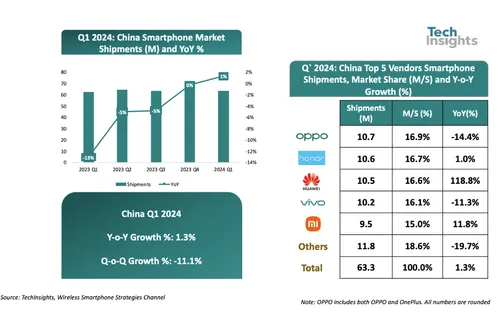
After experiencing eleven consecutive quarters of decline, China's smartphone market exhibited a modest yet significant sign of recovery in the first quarter of 2024. According to market research firm TechInsights, total smartphone shipments reached 63.3 million units, representing a 1% year-on-year increase. This positive shift suggests a potential turning point for the once-troubled industry.
China's Smartphone Market Shows Tentative Signs of Recovery, Domestic Brands Dominate

The data reveals a significant shift in brand dominance within the Chinese market. While Apple previously held a strong position, it has fallen outside the top 5 players in Q1 2024. Capturing only 13.7% market share. This development highlights the growing strength of domestic Chinese smartphone manufacturers.
Oppo, which includes its OnePlus subsidiary, emerged as the leading brand with 10.7 million units shipped and a market share of 16.9%. Honor, Huawei, and Vivo followed closely behind, each holding a roughly similar market share hovering around 16%. Notably, Huawei's performance is particularly noteworthy. Shipments surged by a staggering 118.8% year-on-year to 10.5 million units, propelling it to third place with a 16.6% market share. This resurgence can be attributed, in part, to the successful launch of its 5G-enabled Mate 60 series and continued brand loyalty.
The dominance of domestic brands is further underscored by the combined market share of the top six manufacturers. TechInsights reports that these players now control a staggering 95.1% of the market, up from 93.7% in the previous year. This trend indicates a consolidation within the industry, with Chinese companies solidifying their hold on the domestic market.
While the overall growth is modest, it represents a critical turning point for the Chinese smartphone industry. The resurgence of domestic brands and a potential rebound from Apple suggest a period of cautious optimism. Continued innovation, strategic marketing, and a focus on consumer needs will likely determine the long-term trajectory of this vital sector.
Loading





